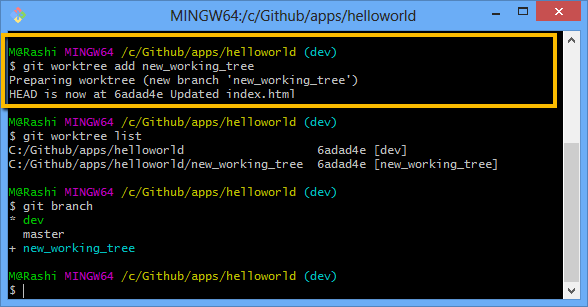Git offers a better and more reliable workflow model – Git worktree. It gives a perfect copy of your entire repository. In this article, I will explain all you need to know about worktree and how you can use it step-by-step with the Git best practices. And once you know all these basics, Git Worktree will be relatively easy to implement as compared to other practices like cloning with Git Clone your repository.
What is Git Worktree
In simple words – Git worktree allows developers to have multiple working directories at the same time and those working directories associated with a single Git repository. If you are working on a large project and have to switch branches to work on different issues, Git worktree can be helpful.
Manage Git Worktrees
Before you start adding a new worktree, let us see how many worktree you have right now.
List Worktrees
You can check with the following command.
At this time, you should see only one worktree. It’s your default worktree.
Add New Worktree
Let us add a new worktree, and you can use the following commands – Once you add a new tree, you can view all the working trees by the worktree list command to confirm that you now have two available trees.
And this newly created working tree known as a linked tree.
Remove Worktree
You might have to delete your worktree for many good reasons like When your work is complete, and it’s safe to delete the linked worktree. You can use the following command to delete the worktree
Why Multiple Worktree
There should be a question in your mind that you would trouble introducing a linked worktree if you already have your main one. Why do you need multiple worktrees? – For parallel development. With multiple worktree you can do parallel development, and also you need these for the following reasons
Parallel Development & Testing
If you are working on a legacy enterprise project, and at some time, you have to fix bugs, and then other hours need to add a feature. In that case, Git worktree will be useful and support parallel development. In the same way, Running multiple test suites in parallel reduces the run time. It is convenient to use various test suites at the same time to test your coverage. It is easy to change your worktree from primary to linked with a simple git command. Also, you can make changes in git worktree by using Git cherry-pick and git reset.
Easy Management
It’s easy to manage your codebase with multiple worktrees as compared to cloning your repository. Git worktree is a lightweight entity, and it is easy to use and manage. When you use the git clone command to your existing repo, you make a full copy of your repository. And It might be possible you create the same branch name in your existing and newly created repo. It might be confusing and hard to manage. Here, the good part about git worktree will allow you to create the same branch name in your primary and linked worktree — so overall, it’s easy management.
Save Time & You Stay Focused
Switching is an expensive operation because when you switch, you completely restructure the repository. And If you change your current working branch from IDE, in that case, your IDE might run mad and try to adapt to the project settings. With the help of a worktree, you can avoid these frequent switching. You can checkout required branches in separate folders using the worktree. So there you will get an independent IDE project for each branch.
Conclusion
Git clone is an older way to duplicate from the principal repository – whereas, Git worktree is one of the best practices. And in the Git worktree, there is no need to worry about the branches. For example, you can not check in the create branch name in linked worktrees. And because they are linked to your repository, so it will be recorded in history.


